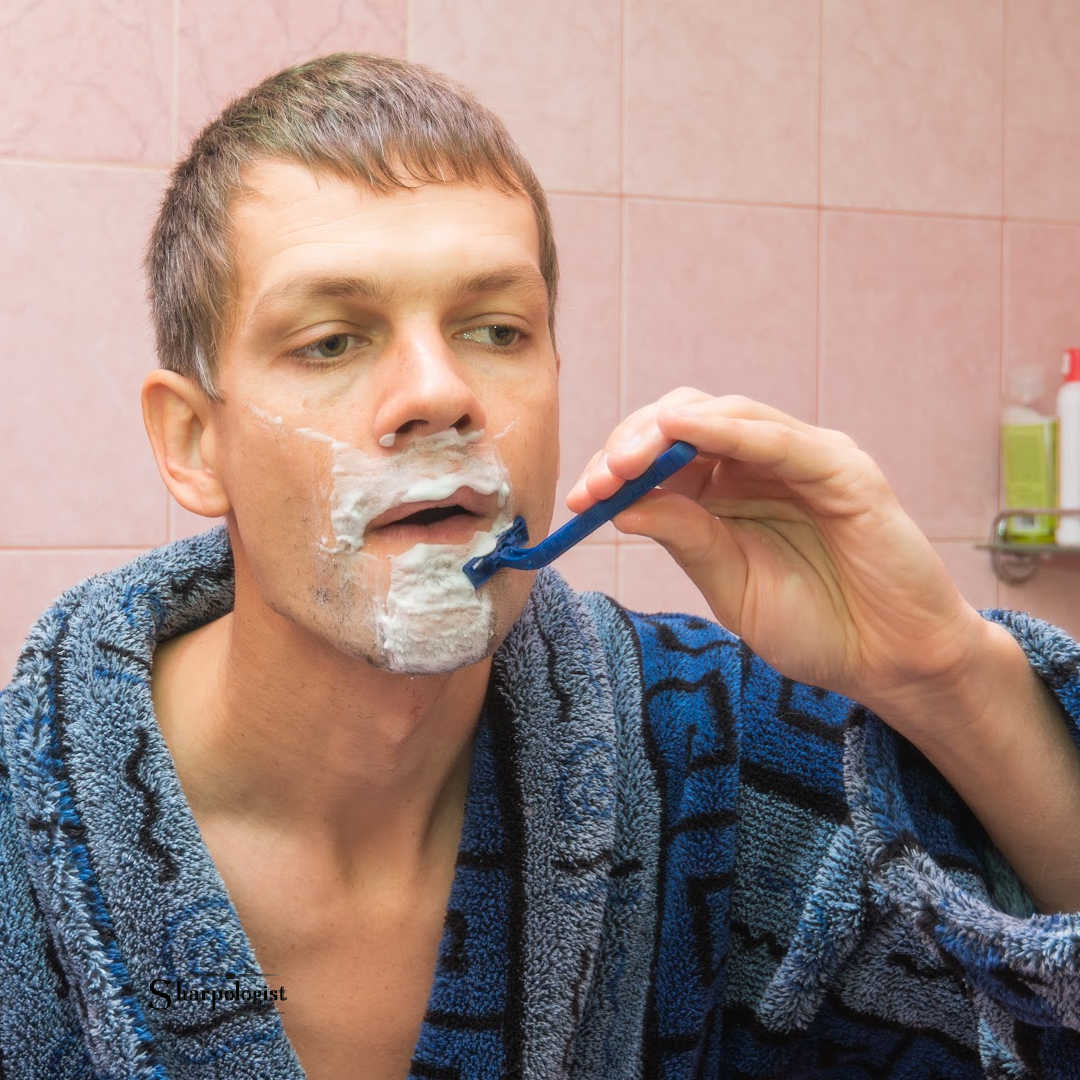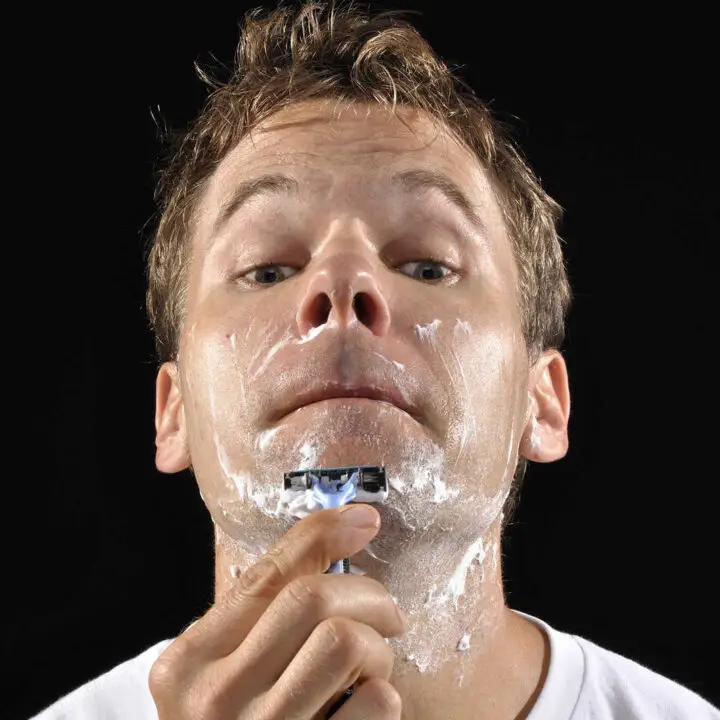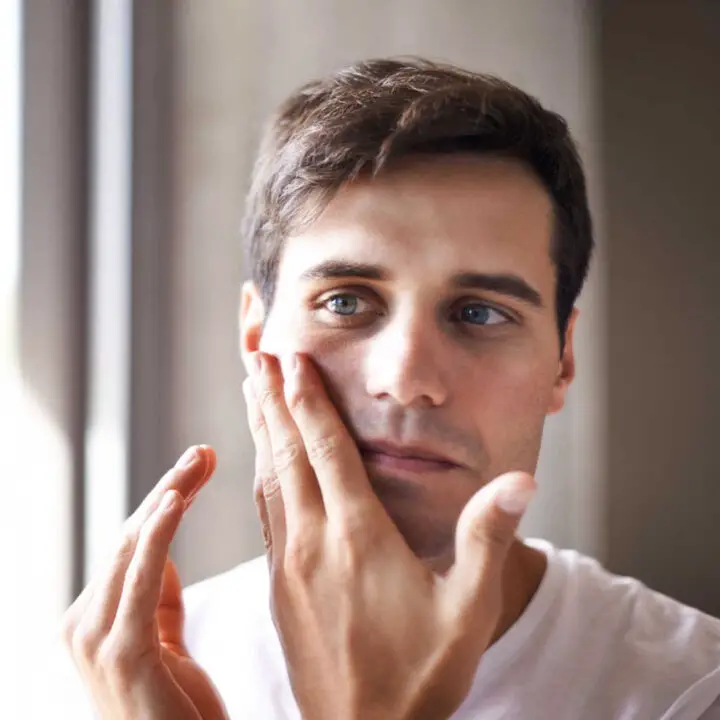
Those undergoing gender reassignment from female to male (“FTM”) often face shaving problems that stem from the transition process itself: patchy or sparse hair growth, increased skin sensitivity, razor bumps, shaving-induced acne, and a steep learning curve for shaving techniques and tools. These issues can be compounded by emotional dimensions such as dysphoria. Solutions revolve around adopting gentle grooming routines, selecting the right products, learning proper shaving techniques, and building emotional resilience. With patience and the right approach, shaving can become manageable.
Background
Recently an older family friend asked me to provide some shaving advice they could pass on to their grandchild who was undergoing gender reassignment from female to male. I decided to pass along that advice here for those in similar situations.
[Note: due to the subject nature of this post, commenting has been disabled.]
How facial skin thickness differs For FTM men
On average, male skin is about 20% thicker than female skin due to higher collagen density and distinct connective tissue arrangement. Individuals assigned female at birth (including FTMs pre-testosterone) typically have softer and thinner skin, less coarse hair follicles, and lower sebum (oil) production.
Testosterone therapy significantly increases skin thickness in FTM men over time. The hormone’s effects stimulate collagen production and increase the density of connective tissue, leading to thicker and firmer facial skin, more pronounced oiliness and larger pore size, and a rougher appearance and texture.
However the transition is gradual and variable. Facial skin in FTMs becomes noticeably thicker, but may not reach the exact thickness of typical male skin, especially for those who begin hormone therapy later in life or have individual genetic factors that influence skin properties.
The Unique Shaving Challenges FTM Men Face

For those undergoing female-to-male (FTM) gender reassignment, shaving facial hair isn’t just a cosmetic routine—it’s a somewhat challenging process. Here are some issues to keep in mind:
1. Sparse and Uneven Facial Hair Growth
- Patchy Beard Patterns: Early in testosterone therapy, most FTM men develop facial hair unpredictably. Growth is often uneven, with some regions producing coarse hair while others remain covered with soft “peach fuzz.” Applying beard oils can help hair appear fuller and support healthy growth.
- Styling Limitations: This makes it difficult to shape or trim a beard or mustache with conventional techniques and can lead to frustration when seeking a more masculine look.
2. Persistent Skin Sensitivity and Razor Irritation
- Heightened Sensitivity: Skin that was previously conditioned by estrogen tends to be thinner and more sensitive, particularly in the first years of hormone therapy.
- Razor Burn and Nicks: Shaving over sensitive, transitioning skin increases the risk of razor burn, redness, and small cuts.
3. Increased Acne and Ingrown Hairs
- Testosterone-Triggered Acne: Elevated oil (sebum) production under testosterone often leads to new acne breakouts, especially around the chin and jawline.
- Ingrown Hairs (Pseudofolliculitis Barbae): As vellus hair converts to thicker, terminal hair, ingrowns become common. Hairs may become trapped beneath the skin, causing irritation and painful bumps.
4. Slow Post-Shave Healing
- Delayed Recovery: Newly thickening facial skin takes time to adapt to regular shaving trauma. Cuts, redness, and irritation may linger longer compared to cisgender men’s skin.
- Increased Risk of Hyperpigmentation: Shaving over acne or irritated skin, especially on medium or darker skin, can cause lingering dark spots.
5. Product Sensitivity and Allergic Reactions
- Shifting Ingredient Tolerance: Testosterone therapy can make skin react differently to ingredients in traditional shaving foams, gels, or aftershaves, resulting in sensitivity or allergy that may not have been present pre-transition.
6. Technical and Psychological Learning Curve
- Mastering Technique: Many FTM men didn’t have the opportunity to learn shaving tips as adolescents. There’s an added challenge in discovering the best tools—manual razors, electric shavers, or trimmers—for their unique skin and hair needs.
- Emotional Weight: Struggles with patchy beards, persistent irritation, or post-shave redness can trigger dysphoria, lower confidence, or amplify anxieties about being “read” correctly in social contexts.
7. Increased Shaving Frequency and Maintenance
- Thicker, Denser Growth: As facial hair becomes coarser and denser with prolonged hormone therapy, frequent shaving or trimming may be required to maintain a tidy look. This extends grooming time and increases the risk of recurring irritation and ingrown hairs.
Pre-Shave: Preparing FTM Skin for Shaving

Before shaving, FTM facial skin tends to be more sensitive, thinner, and softer, particularly in the early stages of testosterone therapy. This heightened sensitivity makes it more susceptible to irritation and discomfort caused by even mild shaving techniques. In the beginning, facial hair growth is frequently patchy or uneven, so it is usually wiser to opt for gentle trimming or limit the areas shaved rather than using aggressive or frequent shaving methods.
As testosterone therapy commences, the skin undergoes changes, notably increased oil production, which leads to oiliness and a greater tendency toward acne outbreaks. This shift in skin behavior can further complicate pre-shave preparations and amplify preexisting sensitivities. To prepare the skin adequately, it is essential to incorporate warm water splashes, gentle non-comedogenic cleansers, and moisturizing pre-shave products; these steps help soften both the skin and developing facial hair, reducing potential irritation during shaving.
Because sensitivities to ingredients can shift with changing hormone levels, it is important to patch test new shaving creams or foams on a small area of skin before full application. This precaution helps identify any negative reactions before widespread use. Ultimately, developing a pre-shave routine that’s tailored to your unique and evolving skin and hair needs will ease discomfort and help you transition into shaving with confidence. Be prepared to adjust your methods and products as your facial hair texture, skin density, and overall skin behavior change over time.
The Shave: Navigating the Act with FTM-Specific Insight
Shaving for FTMs is shaped by ongoing changes in skin and hair texture, with many men initially facing sparse, patchy, or uneven facial hair. The learning curve can feel steep, especially for those who never learned to shave growing up and must now master tools and technique suited to their own developing features. Choosing the right razor—manual or electric—is often a matter of comfort, sensitivity, and hair density.
FTM men frequently experience more frequent nicks, razor burn, and discomfort, particularly if skin is not yet fully “trained” to handle shaving trauma, or if hair is coarse in places and fine in others. Ingrown hairs and pseudofolliculitis barbae (razor bumps) are especially common, as hairs struggle to penetrate skin that’s still transitioning from softer to rougher under hormone influence. Alcohol-based aftershaves, harsh foams, or aggressive blades can exacerbate irritation, trigger allergic reactions, and delay healing.
The Shave Process for FTM Facial Grooming

When it comes time to actually shave, the process for FTM men should be attentive, gentle, and specifically adapted to the nuances of transitioning skin and developing facial hair. Begin by ensuring the chosen razor or trimmer is clean and sharp. For those new to shaving or working with patchy growth, starting with an electric trimmer or a razor designed for sensitive skin can help minimize irritation and accidental nicks.
Products
For manual razors, fewer blades are better. Avoid the latest-and-greatest multi-blade system. Instead, opt for a razor with one or two blades. Single-blade safety razors are excellent for this purpose. If a “classic” double edge safety razor is too worrisome, consider one that is adjustable or has a front-facing pivot like modern cartridge razors.
For an inexpensive, mass-market manual razor consider something like the Gillette SkinGuard.
For electric trimmers or razors, consider a model that is designed to tackle sensitive skin, like a body groomer or a one designed for pubic area shaving, and usable “wet or dry.” Broadly-speaking, foil-type reciprocating designs seem to work a little better than rotary-style trimmers for FTM skin, but there is an element of personal preference here.
For shaving lubrication, avoid shave foams and gels from a pressurized can: the propellant sometimes dries out the skin. Instead, look for a fragrance-free, non-comedogenic product.
Avoid products that have alcohol as a primary ingredient.
Technique
Position the razor or trimmer with light pressure against the skin. It is important to shave in the direction of hair growth—“shaving with the grain”—to reduce the risk of cutting hairs too close, which can lead to ingrown hairs, razor burn, and general skin discomfort. Use smooth, steady strokes, avoiding repeated passes over the same area. Going over any part of the face multiple times, especially with a blade, increases the chance of irritation, redness, and even scarring, particularly if the skin is newly adapting to testosterone or producing increased oil.
For areas where hair is sparse, uneven, or not fully developed, it is generally best to limit shaving or only use a trimmer to tidy up the edges. Attempting to shape or define a beard before there is enough density may result in bald spots, asymmetrical growth, or further irritation to sensitive skin. If your hair grows in multiple directions—common during the early stages of facial hair development—adjust the shaving direction slightly to follow the dominant pattern of growth, but always prioritize comfort.
While shaving, take care not to rush or apply excessive pressure, as these can lead to tiny cuts, particularly in spots with more delicate or inflamed skin. For those with curly hair types, working gently and maintaining sharp blades is especially important to avoid tugging and ingrown hairs. Avoid shaving directly over any acne or actively inflamed areas, since this increases the risk of both short-term discomfort and long-term scarring or hyperpigmentation.
Throughout the shave, periodically rinse the blade or trimmer to keep it free of hair and shaving product buildup. This helps ensure consistent, gentle contact with the skin and prevents accidental dragging. If discomfort arises at any point, pause to assess whether more preparation is needed or if a different tool would be better suited to the specific area.
Post-Shave: Healing and Skincare for FTM Needs

The post-shave phase presents the greatest opportunity—and challenge—for recovery and skin health. For FTMs, post-shave healing is often slower, with skin lingering in a state of heightened sensitivity or inflammation compared to cis men. Micro-cuts, redness, and stinging may persist, especially if shaving is aggressive or over areas that are newly adapting to testosterone.
Ingrown hairs and razor bumps are persistent concerns, particularly with curly hair or patchy new growth. Acne flares can be aggravated by shaving, and healing may slow down if pores become clogged by excess oil or product residue. Product reactions are also more common—testosterone-induced changes to skin composition can make formerly tolerated aftershaves or lotions suddenly irritating.
Hyperpigmentation (dark spots) and scarring are additional risks, particularly for those who shave over active acne or inflamed areas. Medium and darker skin tones are more prone to these issues, and long-term management may require extra vigilance.
Alcohol- and fragrance-free aftershave balms with soothing ingredients like aloe vera or witch hazel support recovery without triggering reactions; avoid an alcohol-based aftershave “splash.” Daily moisturizing with non-comedogenic, fragrance-free products helps repair the skin barrier.
Final Thoughts: Embrace Patience and Personalization
Shaving as an FTM man is a journey shaped by biological change, personal learning, and emotional affirmation. While testosterone will reshape your face and beard over time, the skin will always ask for patience and careful attention. Lean on the experience of other FTM men, seek out supportive communities, and don’t hesitate to consult a dermatologist for persistent issues.
